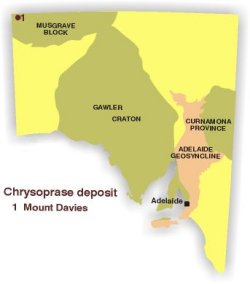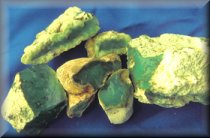 Chrysoprase is a cryptocrystalline variety of quartz (chalcedony) coloured green by a nickel content of 1 to 3%. The best quality material is a rich ‘apple’ green, homogeneous, translucent chalcedony which is used as a simulant for rare and highly prized Imperial Green Jadeite. In Asian markets, chrysoprase traded as ‘Australian Jade’ is in great demand for jewellery. Good green translucent material can demand up to $500/kg.
Chrysoprase is a cryptocrystalline variety of quartz (chalcedony) coloured green by a nickel content of 1 to 3%. The best quality material is a rich ‘apple’ green, homogeneous, translucent chalcedony which is used as a simulant for rare and highly prized Imperial Green Jadeite. In Asian markets, chrysoprase traded as ‘Australian Jade’ is in great demand for jewellery. Good green translucent material can demand up to $500/kg.
Australia is the only significant world producer. It is currently mined in Queensland but has previously been mined intermittently in Western Australia and South Australia. All Queensland production comes from mines owned by GUMAGIL at Marlborough which have been in continuous production for 35 years and currently produce ~80 t/year.
Chrysoprase in South Australia
Mt Davies
The Mount Davies deposits in the far northwest of South Australia (Fig. 1), and Wingelinna deposits 10 km into Western Australia, are located near the western end of the Mesoproterozoic Musgrave Block. Granulite-facies gneiss is host to a series of large, layered gabbroic and olivine gabbroic intrusives of the Giles Complex. Topography is controlled by major west-northwest-trending faults and shears which disrupt both the granulite and Giles Complex. Laterite has developed in places over the more olivine-rich phases of the Giles Complex, and nickeliferous ochre and jasper occur within the laterite profile. Veins of white to translucent chalcedony, chalcedony with manganese or iron oxide dendrites (moss agate) and, less commonly, chrysoprase, have formed within or are spatially related to the jasper (Conor, 1976).
|
|
Intermittent mining has taken place since the early 1960s at six deposits. Production during 1967–69 totalled 2.5 t, but has not been officially recorded since then. Reports of drums of chrysoprase coming from bulldozer operations in the area during 1975–78, and intermittently since, suggest that perhaps 10 t have been mined from deposits 1, 2 and 3, with small amounts scraped from near surface at deposits 4 and 5 (Conor, 1979). In addition, 10 t of carving-grade chrysoprase were mined from deposit 5 in 1996 (Townsend, 1996). Reserves at Mount Davies are unknown, but a drillhole to 200 m near deposit 5 encountered sporadic intersections of chrysoprase, indicating potential for the stone to persist to some depth. The workings have been back filled and the area rehabilitated.
Additional Reading
Conor, C.H.H., 1976. Chrysoprase and moss agate deposits, Mount Davies area, Northwest Province, South Australia. South Australia. Department of Mines. Report Book, 76/22.
Conor, C.H.H., 1979. Chrysoprase and moss agate deposits, Mount Davies, Northwest Province. Report No. 3 — mining activity, 1975–1978. South Australia. Department of Mines and Energy. Report Book, 79/118.
Townsend, I.J., 1996. Gemstones - South Australian chrysoprase. MESA Journal, 2:16-17.



